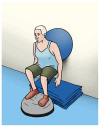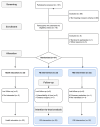Resistance Training with Instability Does Not Hamper Total Training Volume and Muscle Strength Gains in Older Adults: a Secondary Analysis from REI Study
- PMID: 38827426
- PMCID: PMC11100977
- DOI: 10.5770/cgj.27.730
Resistance Training with Instability Does Not Hamper Total Training Volume and Muscle Strength Gains in Older Adults: a Secondary Analysis from REI Study
Abstract
Background: Resistance training with instability (REI) emerged as a promising training modality for older adults aiming to counteract age-related changes.
Objectives: We compared the effects of 12 weeks of REI and traditional resistance exercise (RE) on muscle strength in older adults with cognitive impairment. We further explored if total training volume (TTV) significantly differs among training groups.
Methods: This is a secondary analysis of the REI study. Participants were randomly assigned to REI (n=22) or RE (n=23). RE protocol involved moderate-intensity, free-weight, and machines-based resistance exercises (3 sets, 10-15 repetitions). REI received a similar training protocol, in which exercises were simultaneously performed with instability/unstable devices (e.g., squat exercise under a foam pad or Bosu® ball). Maximal isometric strength and isokinetic parameters were assessed at baseline and after completion of a 12-week intervention through a hydraulic handgrip and isokinetic dynamometer, respectively. TTV (sets × repetitions × load) was computed based on external training load over the 12 weeks.
Results: No differences were observed between groups (p=.35) after the intervention. Over 12 weeks, REI and RE improved isometric handgrip strength (p<.001) and isokinetic performance (p=.04). We also did not find differences in the TTV between training groups (p=.28).
Conclusion: We demonstrated that both REI and RE training induced similar gains in muscle strength. Combining unstable surfaces/instability devices did not hamper TTV, which may have clinical applications in the context of exercise for older adults.
Keywords: aging; instability; muscle strength; resistance training.
© 2024 Author(s).
Conflict of interest statement
CONFLICT OF INTEREST DISCLOSURES: We have read and understood the Canadian Geriatrics Journal’s policy on conflicts of interest disclosure and declare that we have none.
Figures



Similar articles
-
Effects of Resistance Exercise with Instability on Cognitive Function (REI Study): A Proof-Of-Concept Randomized Controlled Trial in Older Adults with Cognitive Complaints.J Alzheimers Dis. 2020;77(1):227-239. doi: 10.3233/JAD-200349. J Alzheimers Dis. 2020. PMID: 32804132 Clinical Trial.
-
Lower-extremity resistance training on unstable surfaces improves proxies of muscle strength, power and balance in healthy older adults: a randomised control trial.BMC Geriatr. 2016 Nov 24;16(1):191. doi: 10.1186/s12877-016-0366-3. BMC Geriatr. 2016. PMID: 27881086 Free PMC article. Clinical Trial.
-
Training load does not affect detraining's effect on muscle volume, muscle strength and functional capacity among older adults.Exp Gerontol. 2017 Nov;98:30-37. doi: 10.1016/j.exger.2017.07.017. Epub 2017 Aug 1. Exp Gerontol. 2017. PMID: 28778747 Clinical Trial.
-
Instability resistance training for health and performance.J Tradit Complement Med. 2016 Jun 30;7(2):245-250. doi: 10.1016/j.jtcme.2016.05.007. eCollection 2017 Apr. J Tradit Complement Med. 2016. PMID: 28417093 Free PMC article. Review.
-
Strength testing and training of rowers: a review.Sports Med. 2011 May 1;41(5):413-32. doi: 10.2165/11588540-000000000-00000. Sports Med. 2011. PMID: 21510717 Review.
References
-
- Cavalcante BR, de Souza MF, Falck RS, Liu-Ambrose T, Behm DG, Pitangui ACR, et al. Effects of resistance exercise with instability on cognitive function (REI Study): a proof-of-concept randomized controlled trial in older adults with cognitive complaints. J Alzheimer’s Dis. 2020 Sep 1;77(1):227–39. doi: 10.3233/JAD-200349. - DOI - PubMed
LinkOut - more resources
Full Text Sources
